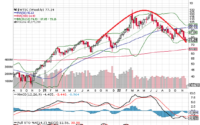It’s the Worst Bond Market Since 1842. That’s the Good News.
So far in 2022, with inflation raging, bonds have lost 10%—among the worst returns in U.S. history. On Wednesday, the Federal Reserve raised interest rates by 0.5 percentage point, the sharpest increase in 22 years.
Yet, just as your body begins healing from an injury before you can feel any improvement, the worst for bond investors might already be ending. Those who dump bonds now might be making a mistake by selling low after buying high.
Let’s start by putting the pain in historical perspective.
The U.S. bond market has had positive returns, before inflation, in all but four years since 1976. Even in 1994, when the Federal Reserve raised interest rates six times for a total of 2.5 percentage points, bonds lost only 3% in the aggregate.
Almost never has the U.S. bond market lost as much money as in the first four months of 2022, according to Edward McQuarrie, an emeritus professor of business at Santa Clara University who studies asset returns over the centuries.
Long-term Treasury bonds lost more than 18% this year through April 30. That surpasses the previous record, a loss of 17% in the 12 months ending in March 1980, says Mr. McQuarrie. The broad bond market has performed worse so far in 2022, he says, than in any complete year since 1792 except one. That was all the way back in 1842, when a deep depression approached rock-bottom.
It’s worth noting that, adjusted for inflation, at least nine past periods have been worse, says Bryan Taylor, chief economist at Global Financial Data, a research firm in San Juan Capistrano, Calif.
Inflation is like kryptonite for bonds, whose interest payments are fixed and thus can’t grow to keep pace with rises in the cost of living. Until recently, inflation seemed like a problem of the distant past, when it often plagued bond investors.
For most of the four decades since 1981, interest rates have been falling and bond prices rising, creating a tailwind of capital gains for fixed-income investors. You not only earned interest on your bonds but pocketed extra profit as they went up in value.
Over some long periods, such as the 20 years ending in March 2020, bonds earned even higher returns than stocks, without any of their bloodcurdling losses.
Those glory years are gone.
“I think the long downtrend in interest rates has finally come to an end,” says Mr. Taylor. “People have been wrong about the direction of rates for 40 years, but I have to think that at this point they might finally be right.”
The prospect of losing money as rates rise seems to be freaking many people out. After pouring $592 billion into bond funds last year, investors have yanked $104 billion so far in 2022, according to the Investment Company Institute.
But a gradual rise in rates isn’t bad for bond investors—so long as inflation comes under control.
Make no mistake: Investing in bonds is an act of faith that the Fed can tame inflation. And that, as U.S. Treasury Secretary Janet Yellen has said, “will require skill and also good luck.”
If the Fed does rein in inflation, though, bond investors should be fine—and should do better over time as they reinvest their income rather than taking it as cash.
Over the long run, the total return of bonds depends far more on their income than on changes in price. Since 1976, just over 90% of the average annual return of the U.S. bond market has come from interest and reinvesting it, according to Loomis, Sayles & Co., an investment manager in Boston.
Thanks to the recent plunge in prices, the yield on the aggregate U.S. bond market, at about 3.6%, has doubled since Dec. 31.
People always chase the past with their money. Investors added more than $445 billion to bond funds in 2020, largely because past returns were so strong. But by the end of that year, the yield on the U.S. bond market had fallen to barely more than 1%—meaning that future returns were bound to be feeble.
Investors were too enthusiastic then. Maybe they’re too pessimistic now.
The single best predictor of the future returns of bonds, before inflation, is their yield to maturity. As prices fall, yields rise, so the recent rout in bonds has raised their expected returns.
“At these starting yields now, you have more cushion to weather rising rates,” says Lauren Wagandt, co-manager of
T. Rowe Price Corporate Income Fund.
“And we’re starting to see some value emerge.”
SHARE YOUR THOUGHTS
Have you taken a beating in the bond market? How have you responded? Join the conversation below.
Yields on corporate bond indexes, she says, are brushing their highest levels in at least 11 years.
The recent rise in yields also means that shorter-term U.S. Treasury securities are likely to be more effective buffers against future declines in stocks.
If your recent losses make you feel like bailing out on bonds, remember why you own them. Bonds aren’t meant to make you rich; they keep you from becoming poor while paying you some income along the way.
“It’s important not to get too emotional about the recent returns we’ve seen,” says Ms. Wagandt. “There’s more income and more value now.”
Write to Jason Zweig at [email protected]
Copyright ©2022 Dow Jones & Company, Inc. All Rights Reserved. 87990cbe856818d5eddac44c7b1cdeb8
[ad_2]
Source link


